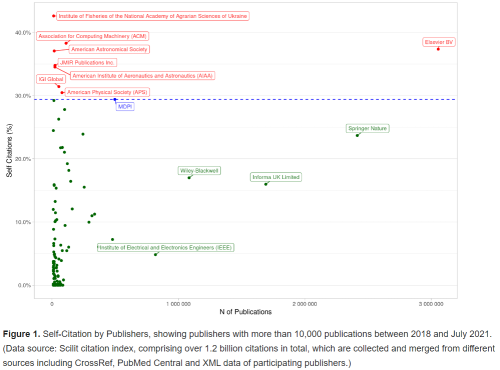They’ll go after you if you call them predatory. From Retraction Watch:
A 2021 article that found journals from the open-access publisher MDPI had characteristics of predatory journals has been retracted and replaced with a version that softens its conclusions about the company. MDPI is still not satisfied, however.
The article, “Journal citation reports and the definition of a predatory journal: The case of the Multidisciplinary Digital Publishing Institute (MDPI),” was published in Research Evaluation. It has been cited 20 times, according to Clarivate’s Web of Science.
Here is the abstract of the article in Research Evaluation:
The extent to which predatory journals can harm scientific practice increases as the numbers of such journals expand, in so far as they undermine scientific integrity, quality, and credibility, especially if those journals leak into prestigious databases. Clarivate’s Journal Citation Reports (JCR), a reference for the assessment of researchers and for grant-making decisions, is used as a standard whitelist, in so far as the selectivity of a JCR-indexed journal adds a legitimacy of sorts to the articles that the journal publishes. The Multidisciplinary Digital Publishing Institute (MDPI) had 53 journals ranked in the 2018 JCRs annual report. These journals are analysed, not only to contrast the formal criteria for the identification of predatory journals, but taking a step further, their background is also analysed with regard to self-citations and the source of those self-citations in 2018 and 2019. The results showed that the self-citation rates increased and was very much higher than those of the leading journals in the JCR category. Besides, an increasingly high rate of citations from other MDPI-journals was observed. The formal criteria together with the analysis of the citation patterns of the 53 journals under analysis all suggest they may be predatory journals. Hence, specific recommendations are given to researchers, educational institutions and prestigious databases advising them to review their working relations with those sorts of journals.
More from Retraction Watch:
Soon after the paper was published in July 2021, MDPI issued a “comment” about the article that responded to Oviedo García’s analysis point by point. The comment called out “the misrepresentation of MDPI, as well as concerns around the accuracy of the data and validity of the research methodology.”
Here is the graph that MDPI is using to suggest “that MDPI is in-line with other publishers, and that its self-citation index is lower than that of many others; on the other hand, its self-citation index is higher than some others.”
From this graph you can see market share in publishing: Elsevier, Springer, Informa (Taylor and Francis) and Wiley Blackwell are the big 4. The next two largest publishers are the Institution of Electronics and Electrical Engineers and MDPI. There are a ton of self-cites in Elsevier journals (the self-citation numbers are at the publisher level). MDPI is comparing itself to, say, the Elsevier and Springer placement on the vertical axis. What this analysis is missing is quality control. There are not many MDPI articles that you’d want to reference because they are mostly low quality. So, self-citation at lower level journals is some evidence of manipulation of journal rankings.
The solution, it seems to me, is to stop trying to label MDPI (and Frontiers) as predatory. Just call them something else like “publishers that manipulate journal rankings and take people’s money in exchange for a shaky review process that ultimately leads to publication.”
